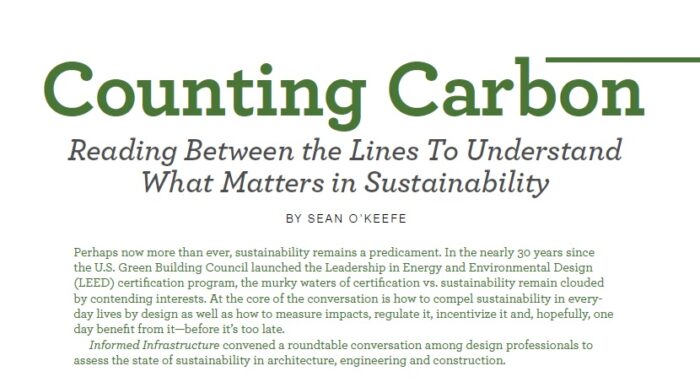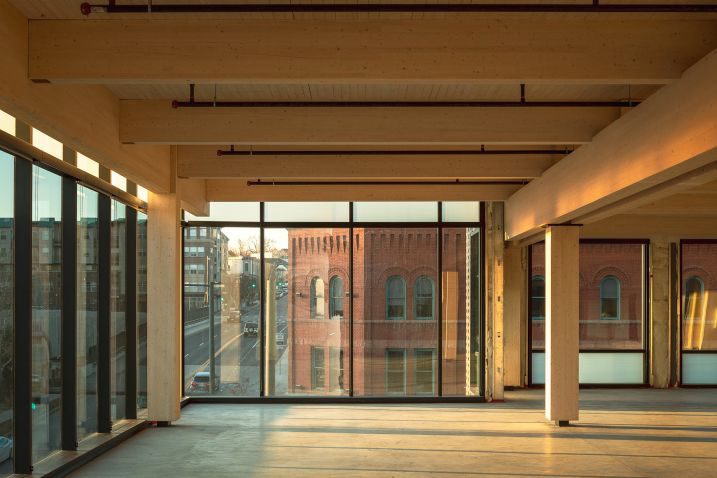Counting Carbon: Reading Between the Lines To Understand What Matters in Sustainability

Informed Infrastructure convened a roundtable conversation among design professionals to assess the state of sustainability in architecture, engineering and construction.
Meet the Panel

Paul Hutton
Paul Hutton has been devoted to sustainable design since before most things were recyclable. During more than 40 years of practice, which included founding a firm and going through a merger, Hutton has had a hand in the evolution of ideas, practice, process and performance across a wide spectrum of possibilities. Today, as the director of Regenerative Design for Cuningham, a national firm with a global presence, Hutton is responsible for maximizing design’s power to restore across the firm’s five practice areas: Grow, Live, Heal, Work and Play.
“What is exciting in my work is seeing issues like embodied carbon finally coming to the fore, after talking about them for the last 45 years or so.”
Alexis Feitel, P.E.

Alexis Feitel, P.E.
Structural Engineer, Embodied Carbon Lead
KL&A Engineers & Builders – Structural Engineering and Construction Management
A P.E. with nearly 10 years of experience, Alexis Feitel represents the next generation of design leadership, a group that will have to break through boundaries for the better. As a structural engineer, her work touches everything from multifamily residential to highrise offices in any combination of concrete, steel and wood. Feitel also serves as the embodied carbon lead for KL&A’s Team Carbon, inhouse expertise focused on embodied carbon quantification, reduction and implementation strategies into building design and (de)construction practices.
“Reducing embodied carbon isn’t about one strategy or the perfect strategy. It’s about what we can do right now. We can’t wait for solutions. We must embrace the opportunities and technologies that exist today, while we push for what’s next, with optimism and urgency.”
Claudia Browne

Claudia Browne
Senior Water Resources Specialist/Ecologist
Biohabitats – Ecological Stewardship
An ecologist and water-resources specialist, Claudia Browne is committed to increasing resiliency at the intersection of human and natural systems. She is the western bioregions operations leader for Biohabitats, a consultancy focused on respecting the Earth’s ecological limits, healing damaged ecological processes, and cultivating beneficial relationships between land and all forms of life. Working with a cross-section of public and private, vertical and flat, local, regional, state and federal, Biohabitats seeks to inspire communities to rediscover a sense of place through the preservation of indigenous ecosystems.
“I’ve seen tremendous evolution of thought and understanding around sustainability over my career. Ecosystem impacts are now coming into focus, and more people are interested in doing the right thing. It’s an exciting time as people begin to take a closer look and measure impacts more carefully.”
Where are we today in sustainability as it relates to architecture, engineering and construction?
“My title used to be chief sustainability officer, but over the last few years, I’ve come to realize that the term sustainability has been worn out,” says Hutton. Cuningham employs some 300 professionals practicing architecture, interiors, urban planning and landscape architecture. With strong portfolios in education, healthcare, office, civic and hospitality, the firm does just about everything. Hutton is responsible for making sure they do it with a focus on what matters most long-term.
“In our practice, Cuningham has retired the word ‘sustainability’ and replaced it with ‘regenerative design,’” he continues. “We believe sustainability has come to mean to do less harm. It’s time to recast this challenge as being agents for the positive forces of rejuvenation and healing rather than making it about conserving energy or saving money.”
Feitel shares that although KL&A Structural Engineers and Builders hasn’t gone as far as retiring the word sustainability, she appreciates the sentiment. As a P.E. whose young career is now in full swing, Feitel is determined to make a positive impact. She sees a holistic and collaborative approach as the best starting point. “Certainly, regenerative design is better than doing less, and on the design side especially, there is a shift taking place. We need to tackle this in all its forms. In certification programs, for instance, the measurements are becoming less prescriptive, less about points on a scorecard, and more about positive impacts in a community and comprehensive environmental considerations.”
Browne’s work resides at the juncture of natural ecology and the built environment. As such, it intersects with virtually everything humans build, one way or another.
“Nature-based solutions should be understood as one of the key answers to climate problems,” says Browne of the role Biohabitats plays in design and development. In its work, Biohabitats applies engagement, assessment, planning, engineering, construction and monitoring services in many forms for everything from infrastructure and urban ecology to land use and conservation. “How you use the land, how you connect to the watershed and preserve the site’s ecological balance are all very long-ranging issues that are a lot easier to get right from the start, rather than needing to resolve and pay for later due to mismanaged or lost ecosystem services.”

Made from young, sustainably harvested trees, CLT is a structural alternative to steel or concrete. Strips of laminated wood create a reliable, high-tolerance structural member that’s naturally beautiful in its unfinished form. KL&A has several CLT projects in progress.
For the greater part of the 21st century, the design industry has focused on energy consumption as the meaningful measurement of the benefits of sustainable design, but a paradigm shift is underway. Today, designers, product manufacturers, corporations and increasingly consumers are counting carbon.
It has long been understood that buildings account for about 40 percent of humanity’s annual carbon dioxide emissions (CO2), which contribute significantly to global warming. Embodied carbon is a quantification of the total carbon emissions associated with the entirety of materials and construction processes required to get a building built and fully operational as well as through its natural lifecycle. This includes all carbon emissions associated with manufacturing, transporting, installing, maintaining and disposing of demolished building materials at the end of their life.
“Energy consumption is one facet of how a building operates. Embodied carbon is a more holistic measurement of a building’s impact on the environment and is locked in once constructed,” says Feitel. In this regard, designers can make design decisions and specify materials to reduce the overall emissions associated with the building from cradle to grave—even beyond that for reusable or recyclable materials. “Every design discipline, every material choice, every logistics choice or constructability solution can and should take carbon into account. We can realize reductions in steel, concrete and wood in architecture, interiors, infrastructure and landscaping; virtually everywhere.”
Carbon has indeed replaced energy in industry certification bodies such as the USGBC and Architecture 2030, and the concept isn’t confined to the design and construction industry. Many of the world’s global corporations have been tracking their carbon-emissions footprint for more than a decade as a measure of corporate governance.
“Beyond the building industry, airlines, clothing lines and consumer brands are all beginning to calculate embodied carbon and publicize it. In the future, carbon cost will be a common consideration, like reading a nutrition label,” says Feitel.
Where can we anticipate change?
Like Feitel, Browne stresses the importance of a balanced approach to problem solving. “Carbon is part of the equation, but we also need to appreciate the importance of biodiversity and healthy ecologies.”
She points out that as with any form of change, there are promoters and resistors.
“Many architects, planners and landscape architects are promoting sustainable design, but there are also a lot of good ideas that don’t get implemented due to value-engineering by single-minded funding,” says Browne.
“In many ways, presently developers aren’t held accountable for what they create, so that’s a barrier to impact reduction,” agrees Feitel. “This is where policy and legislation can go beyond greenwashing to hold building owners to certain metrics.”

Biohabitats helped the Black Swamp Conservancy transform 54 acres of frequently flooded farmland into a functioning floodplain of the Sandusky River, enhancing regional habitat, water quality and riverfront access.(David Ike Photography)
Hutton points out that although the Supreme Court’s recent decision on the EPA’s ability to regulate carbon emission may seem like a severe setback, legislation begins at the municipal level and works its way up, rather than being decided at the federal level.
“I’ve been in architecture for 42 years, and virtually nothing we do is permitted through the federal level,” says Hutton. “At the state and municipal level, the regulatory environment is very progressive. Today, many municipalities have risk-management and resiliency departments. Thoughtful building regulations are essential ingredients in resiliency and risk management.”
Hutton is pleased to have been hands-on in the fight to get new legislation passed in Colorado on the matter.
“In 2021, Colorado passed legislation defining embodied carbon standards for all state-funded projects—that’s roads, bridges, buildings and anything else they build,” says Hutton. Under the law, projects will not only have to meet the set limitations for embodied carbon but will also have to supply Environmental Product Declarations on everything used to build it. “Colorado’s laws follow on the heels of similar legislation in California that went into effect earlier this year. I believe this is just the tip of the iceberg. Many more states and municipalities will jump into this arena.”
The seed change happening within the regulatory environment is fundamental to creating broader industry and investor awareness in general.
“Private projects are also incentivized to align with these limitations via sales tax and permitting benefits,” says Feitel. “There is a lot of space for cities and municipalities to pass legislation around embodied carbon in concrete, asphalt, material use, and material deconstruction process to support reductions and industry innovation.”
Hutton reveals that many leading brands in high-touch industries such as healthcare and hospitality are already expanding their carbon awareness beyond the particulars of a single building to assess the entire spectrum of their operations.
“We have expanded our carbon-calculation capacities for some clients to include a complete carbon account of their full operations,” he notes. “This a carbon profile of not only their real estate portfolio but all their operations, including fleet emissions and employee commutes.”
What’s Next?
As the design community and regulatory interests calculate embodied carbon in new buildings coming online, the research and development community is looking ahead to more regenerative strategies. Working to overcome the damage industrialized humanity has done to the Earth’s many varied environments will require more than simply doing less harm. Indeed, the next generation of building materials must begin reversing the impacts of damage already done.
“Mass timber is a huge opportunity for embodied carbon reduction and C02 sequestration potential,” continues Feitel. “KL&A has a robust portfolio of mass-timber buildings with several in progress.” Mass timber has fueled the design and development industry’s recent gravitation to Cross Laminated Timber (CLT) as a structural alternative to steel or concrete. Typically made from young, sustainably harvested trees, strips of wood are laminated together at alternating directions to form a reliable, high-tolerance structural and architectural manufactured product.
The results are prefabricated CLT floor or wall panels that can be up to five times lighter than concrete, are easily installed and significantly expedite superstructure erection. Most importantly, trees naturally sequester carbon drawn from the atmosphere within their cells as they grow and maintain this carbon storage until burning or decomposition. Because source trees are harvested young, they are replaced quickly compared to the old-growth timber previously required for structural loading members.
“There are also several technologies in development to inject carbon into concrete, which is a way of storing industrialized CO2 to prevent it from getting into the atmosphere,” says Feitel of another emerging solution among structural building materials. “One technology available today requires the concrete ready-mix supplier to have specialized equipment installed at their plant, so right now availability is limited. Precast and repeatable concrete products such as wall panels, double tees, traffic barriers or architectural finish products are a favorable application for carbon-sequestration techniques.”
“One of the biggest and perhaps most-overlooked resources we have in removing carbon from the environment is soil and natural systems,” says Browne. “Minimizing land disturbance, particularly on greenfields, is one of the key strategies for maintaining carbon storage in soil and biomass pools. Supporting soil regeneration through revegetation—in meaningful locations and quantities—can be effective in capturing carbon lost during project construction. Another soil strategy includes applying biochar as a restorative treatment to a damaged landscape, which can increase the site’s carbon-storage capacity. Although this is environmentally effective, currently it’s difficult to obtain enough biochar to recondition soil cost-effectively, so challenges remain.”
Hutton reinforces the notion that the natural environment remains design’s biggest opportunity for impact on the regenerative side of things.
“How we use landscaping, looking intensely at the land and rethinking infrastructure for stormwater, getting rid of turf lawns, and planting more native vegetation currently feel like the best efforts in our practice to this point,” shares Hutton. “Building materials that are regenerative are on the horizon.”
PRODUCT PROFILE
Biohm: England

An award-winning biomanufacturing company focused on research and development, Biohm is allowing nature to lead innovation to revolutionize construction and create a healthier, more-sustainable built environment. A pioneer in the research of bio-based materials, Biohm has focused on developing materials for the built environment since its inception. The company has now produced a mycelium insulation panel that is naturally fire-retardant and will sequester carbon from the biomass by using it as a food source. Mycelium is the vegetative filament root structure of mushrooms. Biohm has used it to develop a commercially viable building insulation material that outperforms the vast majority of currently available synthetic building insulations for thermal comfort and sound attenuation. To grow mycelium, Biohm sources commercial and agricultural by-products that would otherwise go to a landfill to create a completely regenerative manufacturing process. Currently, Biohm estimates its manufacturing process sequesters at least 16 tons of carbon per month.

As a building material, mycelium-based insulation checks all the boxes and then some. It has achieved thermal conductivity lower than fiberglass, mineral wool, expanded polystyrene and extruded polystyrene. Testing demonstrates that mycelium releases significantly less heat and smoke when burning, which reduces the speed of a fire’s spread and eliminates the toxic smoke produced by other insulations. This breathable material wicks moisture and contains negligible amounts of volatile organic compounds.
Blue Planet Systems: USA


Located in Los Gatos, Calif., Blue Planet Systems is on a mission to mineralize billions of tons of CO2 from the waste stream to be permanently stored in the built environment. Blue Planet Systems developed a mineralization process that uses CO2 from any source as a feedstock for a carbon-negative aggregate. Waste CO2 is combined with calcium sourced from waste to manufacture a synthetic limestone aggregate that safely and permanently stores CO2 in carbonate rocks that can be recomposed into many aggregate-based building materials. Calcium can be sourced from concrete, cement kiln dust, steel slag, fly ash, bauxite residue and silicate rocks. Likewise, CO2 can be sourced from cement plants, iron and steel plants, natural-gas power stations, refineries, direct-air capture, and hydrogen. The CO2 does not need to be purified or liquified. Blue Planet can use flue gas directly or pure CO2 from manufacturing process streams. Blue Planet produces coarse and fine aggregates that have been tested to ASTM specifications and shown to perform comparably or better than existing products. One hundred pounds of Blue Planet aggregate contains 40 pounds of net sequestered CO2. Blue Planet’s aggregates are useful in most concrete mixes and can help turn any highway or highrise into a carbon-sequestering marvel of global value.
CarbiCrete: Canada


Based in Montreal, CarbiCrete is a carbon-removal technology company developing innovative, low-cost building solutions that reduce greenhouse gas emissions. Typically, concrete is made from a mix of cement, aggregate and water. CarbiCrete’s patented technology uses slag from steel factories to replace cement as a binding ingredient in precast concrete products. CarbiCrete is being used to cast conventional CMU blocks using conventional equipment. To cure the concrete, it is placed in a specialized absorption chamber into which CO2 is injected. The CO2 reacts with the steel slag to activate a carbonization process that converts the CO2 into stable calcium carbonates. The carbonates densify the concrete, filling voids in the matrix while permanently capturing the injected CO2. Within 24 hours, the concrete has reached full strength. When compared with cement-based CMUs, CarbiCrete CMUs exhibit equivalent or better mechanical and durability properties. They have the same water-absorption properties, but higher compressive strength by up to 30 percent and display better freeze-thaw resistance. Even when the impacts of additional transportation are considered over locally manufactured products, CarbiCrete’s third-party certified Lifecycle Analysis results in a net carbon-negative concrete product for a wide range of building materials.
Interface Flooring: USA


Headquartered in Atlanta, Interface is a global flooring manufacturer that has been on a path to reduce its negative impact on the environment and become a restorative enterprise for nearly 30 years. Following the example of visionary founder Ray C. Anderson, Interface has been working to lower the carbon footprint of its flooring products since 1994. In 2018, Interface verified that all the flooring products it sells are carbon neutral across their full lifecycle. Today, Interface is taking it a step further and using carbon as a resource to make products that go beyond neutral and begin to help restore the health of the planet. Innovations around using recycled content and bio-based materials have resulted in carpet tiles that are net negative for CO2 emissions when measured from raw material extraction through manufacturing. Interface’s new line of carbon-negative carpet tiles has launched as part of the Embodied Beauty Collection. The carbon-storing material in these tiles will remove more greenhouse gasses from the atmosphere during production than are emitted by creation of the product. Inspired by Japanese aesthetics, the Embodied Beauty carpet collection offers a range of styles and colorways that celebrate the natural world’s organic beauty.
LAMBOO: USA


Lamboo is a U.S.-based manufacturer and supplier of architectural solutions using one of the most rapidly renewable resources on the planet: bamboo. From its office and production facilities in Litchfield, Ill., Lamboo manufactures high-quality interior, exterior and structural building components that can be specified by designers to meet a wide range of needs. Bamboo is a vital and potentially underappreciated ally in the fight against global warming. Bamboo rapidly sequesters carbon in biomass and soil, taking it out of the air more than almost any other plant on earth. One newly planted bamboo plant can sequester an estimated 2 tons of carbon dioxide in just seven years, compared to a typical hardwood tree, which would take nearly 80 years to sequester the same. Of equal value, bamboo thrives in places otherwise inhospitable to vegetation. And although merely grass, it has the compressive strength of concrete and the tensile strength of steel. Lamboo manufactures Glu-lam beams, straight and curved beams, and posts and purlins on the structural side. Exterior products include doors and windows, curtain wall and storefront systems, cross-laminated exterior panels, rain screens, and composite siding and decking solutions. Interior products include solid panels and veneers as well as acoustic panels.
MCi: Australia


Founded in 2013, Mineral Carbonation International (MCi) developed a scalable carbon-platform technology that safely captures and converts industrial CO2 emissions into solid bulk building materials such as concrete, cement and plasterboard. Following more than 15 years of intense R&D, MCi uses a natural process called mineral carbonation to capture carbon in the form of a gas and turn it into a solid that can be used as a material resource. While Earth’s mineral carbonation process converts carbon to a solid during the course of millions of years, MCi’s process can do the same thing in a matter of hours. Once converted, the solid materials called carbonates become the base material for the new sustainable building materials, representing the building blocks of the next generation of large-scale infrastructure. MCi is currently working with cement industry groups and standards bodies for material accreditation for use in building products that will help deliver low-carbon, neutral and carbon-negative infrastructure in the future. Likewise, a new carbonate-based plasterboard MCi is developing is lighter than gypsum-based drywall, fire-retardant and represents approximately 50-percent embodied emissions by weight.
About Sean O'Keefe
Sean O'Keefe is an architecture and construction writer who crafts stories and content based on 20 years of experience and a keen interest in the people who make projects happen; email: [email protected].



